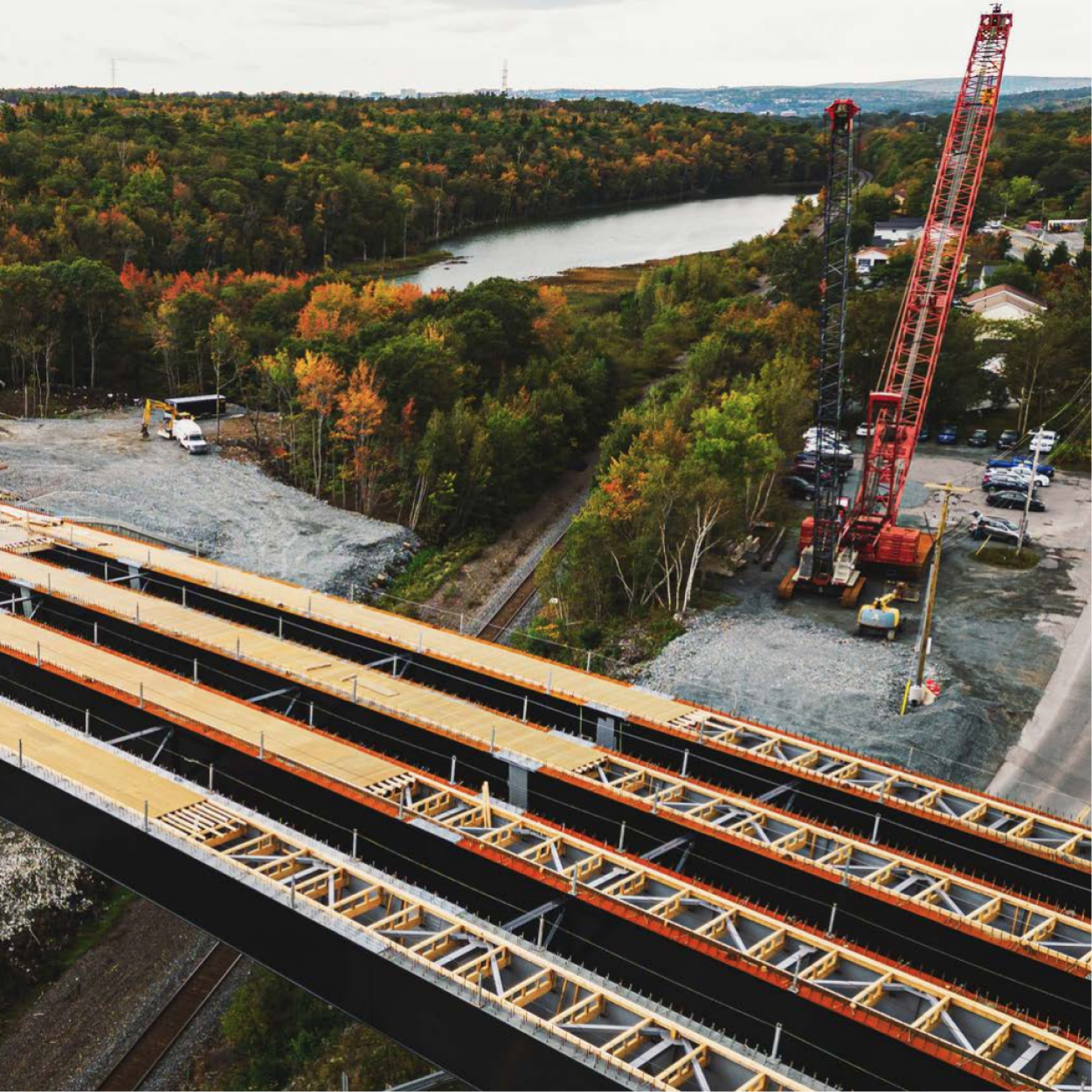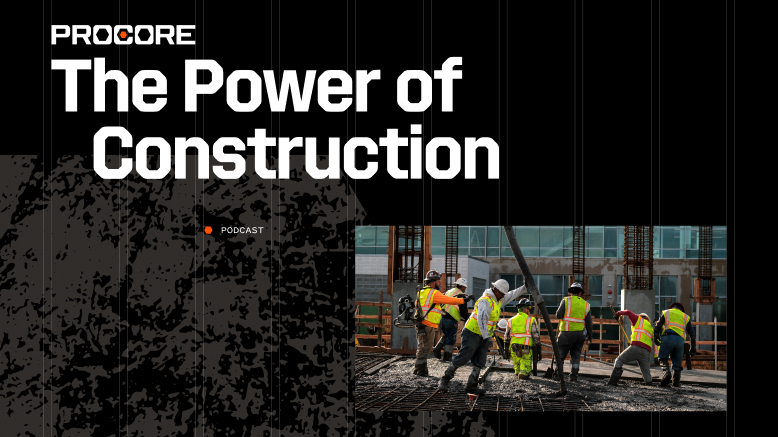— 12 min read
Heavy Civil Construction Estimating: Strategies and Challenges


Last Updated Mar 21, 2025

Alex Six
Solution Specialist, C&I Industry Specialist
16 articles
Alex Six is an Enterprise & Strategic Civil & Infrastructure Overlay Account Executive for Procore. Alex has a long background in the construction industry beginning with an internship with one of the biggest contractors in the world, and expanding across projects with teams as small as 4 people and as large as multi-billion dollar budgets with large teams and disciplines. His resume includes Caltrans highways & bridges, Metro light rail & underground, as well as airport runways and utilities.

Taylor Riso
Contributing Writer
91 articles
Taylor Riso is a marketing professional with more than 10 years of experience in the construction industry. Skilled in content development and marketing strategies, she leverages her diverse experience to help professionals in the built environment. She currently resides in Portland, Oregon.
Last Updated Mar 21, 2025

Accurately estimating the costs of heavy civil construction projects requires a comprehensive understanding of the unique challenges and complexities involved. From vast project scopes to intricate regulatory requirements, heavy civil construction estimating differs significantly from non-heavy civil projects.
This article aims to illuminate these differences, offering detailed insights into the essential aspects of heavy civil construction estimating. By understanding these nuances, construction estimators, project managers and civil engineers can improve their planning processes, risk management and overall project success.
Table of contents
Importance of Accurate Estimating in Civil Construction
Heavy civil construction encompasses large-scale infrastructure projects such as roads, bridges, tunnels and dams. These projects are vital for maintaining and improving public infrastructure, delivering essential services and ensuring connectivity.
Unlike residential, commercial or industrial construction, heavy civil projects often span vast areas and require extensive planning and resources. They involve specialized materials like bulk concrete and steel, as well as heavy machinery such as excavators and cranes, which are integral to executing these massive undertakings.
Accurate cost estimation is paramount in construction projects, especially for heavy civil construction, where the stakes are significantly higher. Estimating in this domain is not merely about calculating the cost of materials and labor but also involves a deep understanding of the project's scope as well as the myriad of potential risks and logistical challenges.
In heavy civil construction, the scale of projects means that even minor errors in estimation can lead to substantial financial losses.
For instance, underestimating the amount of excavation required for a highway project can result in cost overruns and delays, impacting both the project timeline and budget. Heavy civil estimators must consider numerous variables, including soil conditions, weather patterns and site accessibility, which can all significantly influence project costs.
Moreover, heavy civil projects often involve multiple stakeholders or Authorities Having Jurisdiction (AHJ), including government agencies, public interest groups and large engineering, procurement and construction (EPC) contractors. Obtaining permits, securing funding and managing stakeholder expectations all depend on the accuracy of estimates. Transparency in the estimating processes — supported by detailed data and historical performance metrics — builds trust and protects project feasibility.
Estimating for heavy civil projects also involves handling a high degree of risk. Unforeseen challenges, such as discovering unexpected underground utilities or dealing with adverse weather conditions, can disrupt project schedules and increase costs. A robust risk management strategy, incorporating contingency plans and flexible resource allocation, is vital for mitigating potential issues.
In contrast, non-heavy civil projects typically involve smaller scales and more predictable conditions, making their estimating processes relatively straightforward. However, the complexity and magnitude of heavy civil projects require a more sophisticated approach, underscoring the importance of experience and expertise in this field. By leveraging advanced estimating tools and methodologies, construction professionals can enhance accuracy, improve budgeting and secure the successful completion of these projects.
Unique Challenges in Heavy Civil Construction Estimating
Estimating for heavy civil construction projects presents distinct challenges that require specialized strategies and a deep understanding of the complex variables involved.
Scope and Scale Differences
Accurate cost estimation in heavy civil construction is essential due to the expansive scope and complexity of these projects. Estimating involves understanding the project's extensive breadth, potential risks and logistical challenges. Heavy civil projects — such as highway widening or light rail installations — span vast geographic areas and involve intricate logistics. Even minor errors can lead to significant financial losses, such as underestimating excavation requirements, resulting in budget overruns and delays. Evaluating variables like soil conditions and site accessibility is key.
For example, the complexity of highway projects, which may cover hundreds of miles, requires detailed and segmented estimates. These projects often span several years, posing challenges in forecasting costs over extended periods and accounting for potential economic fluctuations. Estimators must accurately predict labor costs for substantial workforces, including skilled trades and heavy equipment operators.
The sheer volume of materials, such as bulk concrete, asphalt and steel, demands precise estimating to avoid costly overruns. The specialized and costly equipment used in these projects necessitates sophisticated planning for procurement, operation and maintenance over large distances.
Top Civil & Infrastructure Trends
Discover insights from over 450 civil and infrastructure professionals on industry trends, challenges, business drivers, and success recommendations.

Types of Materials and Equipment Used
Heavy civil construction relies heavily on specific materials and machinery to meet the demands of large infrastructure projects.
Specialized Materials in Heavy Civil Construction
Key materials in heavy civil projects include:
- Bulk concrete: Essential for constructing foundations, bridges and tunnels.
- Asphalt: Widely used in road construction and paving.
- Large quantities of steel: Used for reinforcing structures, building frameworks and supporting large spans.
These materials are procured in significant volumes, necessitating precise cost estimation to manage the substantial quantities required for such extensive projects. Accurate estimation must account for not only the cost of materials but also the logistics of procurement, transportation and storage.
Heavy Machinery and Equipment
The specialized machinery required for heavy civil construction includes:
- Excavators: For digging and earthmoving tasks
- Cranes: Necessary for lifting heavy materials and components
- Bulldozers: Used for grading and moving large amounts of earth
- Other large equipment: Including things like loaders, graders and pavers
Managing these machines involves considerable logistical planning and costs, including transportation to the site, operational expenses and maintenance. Ensuring that heavy machinery is properly stored and maintained plays another large part in preventing downtime and extending equipment life.
Regulatory Considerations and Public Involvement
Heavy civil construction projects must comply with a complex array of regulations and involve multiple stakeholders to ensure successful execution. These projects often intersect with public infrastructure, necessitating coordination with government agencies, environmental bodies and community groups.
Compliance and Coordination
Compliance with regulatory standards includes adhering to safety protocols, environmental regulations and specific contractual terms and conditions. Public projects, especially those funded by government entities, require rigorous documentation and reporting to demonstrate compliance. Each phase of the project may require permits and approvals, which means staying aligned with the regulatory framework is critical to maintaining the project schedule.
Environmental Constraints
Heavy civil projects frequently encounter environmental constraints that must be meticulously managed. For example, construction near protected habitats or waterways necessitates special permits and adherence to environmental protection guidelines. Projects may also face restrictions based on seasonal weather patterns, which can affect work schedules and require additional planning.
Community Impact and Public Relations
The community impact of heavy civil projects is significant. These construction activities can affect local residents, businesses and daily traffic patterns on a large scale. Effective public relations strategies help to maintain community support and manage public expectations. It’s important to implement regular, transparent communication and responsiveness to community concerns. For example, highway construction often requires night-time work to minimize traffic disruptions, but this must be balanced with noise ordinances and public convenience.
Stakeholder Engagement
Involving multiple stakeholders early and often is an important factor in project success. This includes local government officials, utility companies, environmental groups and the general public. Each stakeholder has unique concerns and requirements that must be addressed to prevent delays and conflicts. Engaging stakeholders through public meetings, feedback sessions and collaborative planning efforts can help align the project goals with community needs and regulatory requirements.
Estimating Methodologies and Tools
Effective estimation in heavy civil construction involves using a variety of tools and methodologies to ensure accurate and transparent cost projections.
Tools and Software
Estimators utilize a range of software tools to compile and analyze data. These tools facilitate the breakdown of extremely complex projects into manageable parts, allowing for detailed cost analysis of materials, labor and equipment. By leveraging digital solutions, estimators can create comprehensive and precise estimates that account for all aspects of a project.
Open-Book Estimating
Open-book estimating is a widely used methodology in heavy civil construction. This approach involves complete transparency in the estimation process, where all assumptions, costs and calculations are shared with stakeholders. This transparency builds trust among project participants — including owners, contractors and regulators — ensuring that everyone has a clear understanding of the financial aspects of the project. Open-book estimating promotes accountability, reduces disputes and leads to better project outcomes through improved decision-making and stronger working relationships.
Transparency in Cost Estimation
Establishing transparency in the cost estimation process is vital for managing change orders and unexpected project developments. When estimates are open and detailed, it becomes easier to address any modifications or unforeseen issues that arise during construction. Clear documentation of cost assumptions and methodologies helps in maintaining accountability and facilitates smoother negotiations and adjustments.
Importance of Detailed Data
Accurate estimates are supported by detailed historical data and performance metrics. Estimators draw on past project data to inform their predictions, adjusting for current conditions and specific project requirements. This data-driven approach enhances the reliability of cost projections and helps in identifying potential risks and opportunities for savings.
Risk Management and Contingencies
Effective risk management and contingency planning are critical in heavy civil construction due to the high degree of unpredictability inherent in these projects. Estimators and project managers must consider various risk factors and develop robust strategies to mitigate potential issues.
Risk Factors
Some risks include:
- Unforeseen site conditions: Heavy civil projects often encounter unforeseen subsurface conditions, such as uncharted utilities or contaminated soil, which can cause significant delays and cost increases.
- Weather impacts: Adverse weather conditions, like heavy rain, snow, or extreme temperatures, can disrupt construction schedules and necessitate additional resources to manage.
- Regulatory hurdles: Handling the complex regulatory environment requires careful planning and compliance with various permits, environmental regulations and safety standards. Regulatory changes or delays in obtaining approvals can also impact project timelines and costs.
Contingency Planning
To address these risks, companies incorporate contingencies into their estimates. This involves setting aside funds and resources to cover unexpected events and adjustments. Contingency amounts are determined based on the likelihood and potential impact of identified risks.
Risk Registers
A risk register is another vital tool used to document and manage risks throughout the project lifecycle. It includes detailed information on identified risks, their potential impact, likelihood and mitigation strategies. By regularly updating the risk register, project teams can proactively address issues as they arise.
Self-Perform vs. Subcontracting in Heavy Civil Construction
Understanding when to self-perform work versus hiring specialty subcontractors impacts the bottom line or, in other words, the estimate. This decision is influenced by factors such as expertise, scheduling and cost-effectiveness, which are vital for accurate cost-efficiency and project delivery.
Self-Perform Work
In heavy civil construction, self-performing a majority of the work is common due to the ability to control quality, schedule and costs directly. Estimating for self-performed work requires an in-depth understanding of the company’s capabilities and historical performance on past jobs. This involves accurately predicting labor costs, equipment usage and productivity rates. By leveraging in-house expertise and past project data, companies can develop precise estimates and manage risks more effectively.
Self-performing allows companies to use their own workforce and equipment so that tasks are completed to their standards. This approach also enables more flexible and responsive project management, as adjustments can be made swiftly without needing to coordinate with external parties. For example, a company might self-perform tasks like mass excavation or concrete placement because they have the necessary equipment and experienced crews.
Specialty Subcontracting
While self-performing significant portions of the work, heavy civil construction projects also rely on specialty subcontractors for specific tasks requiring specialized skills and equipment. Examples include landscaping, soil nailing and drilling.
Ensuring the successful completion of these specialized tasks depends on the selection of the right subcontractor partners. It is important to choose speciality contractors with proven expertise and a track record of reliability. Proper vetting ensures that the subcontractors can meet the project's quality standards and deadlines. Additionally, clear communication and detailed contracts help define the scope of work, performance expectations and integration with the primary contractor's schedule.
Incorporating specialty subcontractors can be more cost-effective and efficient for tasks outside the core competencies of the primary contractor. By outsourcing these tasks, companies can focus on their strengths while ensuring that specialized work is performed to the highest standards.
Stay updated on what’s happening in construction.
Subscribe to Blueprint, Procore’s free construction newsletter, to get content from industry experts delivered straight to your inbox.

Strategies for Effective Estimating
Effective estimating in heavy civil construction requires a comprehensive approach grounded in best practices and strategic planning. These include the following:
Leverage historical data and experience.
Historical data and experienced estimators are extremely helpful for creating accurate bids in heavy civil construction. Experienced estimators draw on past project data to inform their predictions, adjusting for current conditions and specific project requirements. For example, previous projects’ performance metrics on excavation rates or concrete usage can help refine current estimates. This historical data allows estimators to anticipate potential issues and make more informed decisions, ultimately leading to more accurate and reliable bids.
Implement innovative approaches to problem-solving.
Innovative approaches and creative problem-solving are essential for optimizing project costs and timelines. For instance, discovering and utilizing local materials, such as free sand left over from a city project, can significantly reduce costs. Experience and creativity enable estimators and project managers to identify unique opportunities for cost savings and efficiency. By thinking outside the box, construction professionals can develop strategies that improve project performance and reduce expenses.
Consider cost management — and change orders.
Cost management throughout the project life cycle involves detailed processes, including handling change orders and force count analysis. Estimators must adjust and refine their estimates as the project progresses, taking into account any changes in scope or unforeseen conditions.
For example, encountering unexpected underground utilities may require adjustments in the budget and timeline. A thorough understanding of contractual obligations and rate tables, especially when working with public entities, ensures that all costs are accounted for and managed effectively. By continually updating estimates and managing change orders efficiently, estimators can maintain control over project costs and confirm successful project completion.
Estimating for Tomorrow's Infrastructure Today
The future of heavy civil construction lies in embracing a holistic approach to estimating, one that values transparency and innovative problem-solving.
By encouraging collaboration, embracing technology and leveraging detailed historical data, the industry can handle the complexities of large-scale projects with greater confidence and efficiency. This shift improves cost accuracy and project timelines and reinforces the importance of sustainable practices and community engagement. As we build the infrastructure of tomorrow, the commitment to excellence in estimating will pave the way for resilient and forward-thinking development.
Was this article helpful?
Thank you for your submission.
67%
33%
You voted that this article was . Was this a mistake? If so, change your vote
Scroll less, learn more about construction.
Subscribe to The Blueprint, Procore’s construction newsletter, to get content from industry experts delivered straight to your inbox.
By clicking this button, you agree to our Privacy Notice and Terms of Service.
Thank you!
You’re signed up to receive The Blueprint newsletter from Procore. You can unsubscribe at any time.
Categories:
Written by

Alex Six
Solution Specialist, C&I Industry Specialist | Procore Technologies
16 articles
Alex Six is an Enterprise & Strategic Civil & Infrastructure Overlay Account Executive for Procore. Alex has a long background in the construction industry beginning with an internship with one of the biggest contractors in the world, and expanding across projects with teams as small as 4 people and as large as multi-billion dollar budgets with large teams and disciplines. His resume includes Caltrans highways & bridges, Metro light rail & underground, as well as airport runways and utilities.
View profile
Taylor Riso
Contributing Writer
91 articles
Taylor Riso is a marketing professional with more than 10 years of experience in the construction industry. Skilled in content development and marketing strategies, she leverages her diverse experience to help professionals in the built environment. She currently resides in Portland, Oregon.
View profileExplore more helpful resources

How Close Are We to Bridging the Design-Build Divide?
For decades, construction decisions have often been made based on gut instinct. But what if the real barrier to transformation isn’t technology—it’s the divide between design and construction? In episode...

What Happens When Data Drives the Business?
Construction has long been seen as a low-margin industry. But what if the real problem isn’t the margins—it’s how decisions get made? In episode 17 of The Power of Construction,...

Preconstruction Partnerships: How Safety Pros Can Collaborate with Estimating & Proposal Teams
Construction leaders and safety professionals are developing a strong understanding of how safety programs positively impact project outcomes. When safety is woven into every aspect of operations from pre-construction to...

Estimate vs. Budget: Tools to Guide Construction Financial Planning
Whether building a residential home, a commercial complex or a large-scale infrastructure development, understanding and managing costs is key to completing a project on time and within financial limits. Effective...
Free Tools
Calculators
Use our calculators to estimate the cost of construction materials for your next project.
Templates
Find a template to help you with your construction project tasks.
Material Price Tracker
Get the latest U.S. retail prices and view historical trends for common building materials.
Glossary
Explore key terms and phrases used in the industry.
